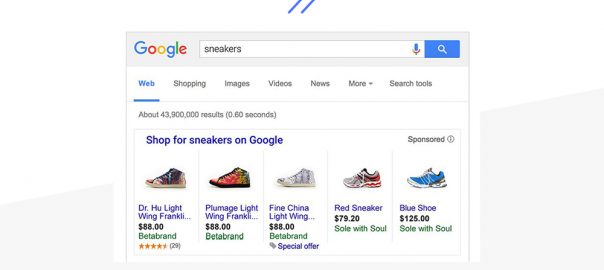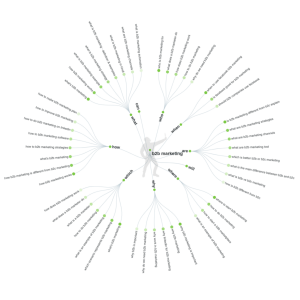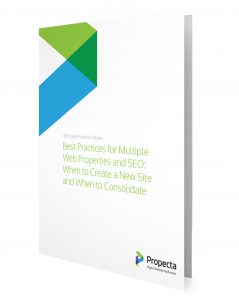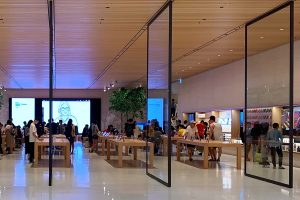September 12, 2016
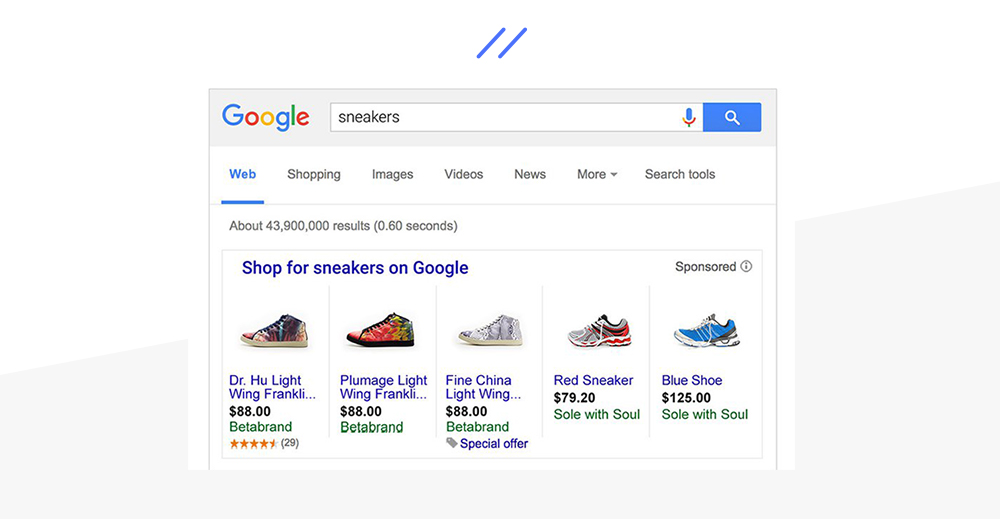
More than 1/3 of all online product searches begin on Google.
Read that again. Not just searches, but “product searches” further making Google a priority advertising arena for anyone looking to get their product in front of a ready-to-buy consumer.
But like anywhere else on the web, competition is fierce.
Sure, you can and should optimize for search rankings using keywords, on-site copy, meta data and the like. Ultimately, your goal should be to displace as much of your search engine marketing spend as possible by winning organically on target keywords.
And yet, even if you are successful, you’ve likely only solved your need for text ads on Google. Google Shopping is a whole other ballgame –– and it serves your brand much more qualified traffic.
Here’s why: Google Shopping is optimized for conversion based on factors known to engage online shoppers with a product. These include showcasing:
- Product image
- Price
- Discounts (if they apply)
- Reviews
- Locality
Plus, if you optimize your site well –– or use text ads on Google –– it’s likely that both your Shopping Ads and your site will show up one after the other on the search results page, increasing your chance for click-thru traffic.

So, when it comes to Google Shopping Ads –– little else can compete.
These ads place relevant products in front of customers using targeted keywords to find the item they want. Plus, these ads showcase those products in ways proven to increase conversion online.
Knowing how important these ads are to online retailers, we caught up with 15 ecommerce experts and asked them for their #1 tip on how to optimize Google Shopping ads (or Product Listing Ads) to increase return on ad spend (ROAS). Here’s what they had to say.
Brett Curry, CEO, OMG Commerce

Get your feed right! Work to properly optimize your titles, descriptions, product types and other required data points. While data feeds aren’t sexy, they are the foundation of your Google Shopping campaign. A weak or under-optimized feed leads to anemic Google Shopping campaigns.
At best your campaigns will be an uphill battle if your feed is under optimized. I could argue that bidding and is where the “magic happens” for Google Shopping, but without the proper feed everything else suffers.
Larry Kim, Founder, Wordstream

We’re seeing ridiculously high returns on ad spend (the range of 16x-32x!) using Remarketing and Customer Match Audiences for Google Shopping. If you’re limited by budget (which is generally the case), this really is your lowest hanging fruit by an order of magnitude.
Jason Dea, Director of Product Marketing, Intelex

Don’t be afraid of Google Shopping. While your own native store and marketing programs may be your personal passion, big brands scale their growth through nurturing customers in multiple channels. In this case, Google Shopping provides the potential to scale your marketing reach to Google’s very broad –– and valuable –– audience.
William Harris, Ecommerce Consultant, Elumynt

Get granular with your bids. Every product has a different profit margin and different profit amount in terms of dollars. You should be bidding on each product according to the amount you can afford for each product.
If you have 35,000 products, that might seem daunting to you. Hiring the right agency to manage this can usually more than make up for the cost by making each product more profitable.
Jan Lastuvka, CEO & Co-Founder, MonkeyData

Set negative keywords to your campaigns so that you do not pay for clicks that are not related to your budget. For example, if you sell baseball cleats, set [-football] and [-rugby] as negative keywords so that people looking for these products do not see your ads and therefore do not potentially click on them, driving up your costs when they’re not actually interested in your products.
Catalin Zorzini, Founder, Ecommerce-Platforms.com

My best advice for selling here is integration. Once you establish a presence on Google Shopping and build your own brand, it’s actually not that different from managing your online store.
Accepting payments and completing orders should come easy, but it’s your ecommerce platform that dictates how easy it is to integrate with your online store and make sure that all the right details are displayed on the Google Shopping pages.
For example, BigCommerce has most of the functionality built in for your own use. This ensures that customers won’t be disappointed when you’re out of stock or if your product details conflict with what actually comes with an item. Not to mention, you can spend more time discovering other marketing tactics through Google Shopping.
Jacob Firuta, Content Manager, LiveChat

Google Shopping is one of the most reliable paid ways of getting people on your product pages. And that’s no surprise –– since all offers are tailored to the past browsing history of a user. If you don’t have a huge budget, try going for the smaller, more precise keywords. You’ll avoid the biggest players this way and you’ll also get to market to a smaller niche where the conversion rate should be higher.
Drew Sanocki, Private Equity Operating Partner, Empire Growth Group

Identify your top 10% of products (that drive the most revenue) then do custom optimization of these (pricing, headlines, text) to get them to the top of the rankings.
Michael Ugino, Co-founder, Sellbrite

Be sure your store will benefit from Google Seller Ratings. Apply to be a Google Trusted Store, and use a review tool like TrustPilot or Yotpo to drive reviews for your products. Also, optimize your data feed! If you’re sending Google incorrect information about your products, like the wrong pictures, wrong categories, it can really stall your ROAS.
Aaron Agius, Managing Director, Louder Online

Obviously, when you’re optimizing your PLAs, you want to do things like keep your feed updated and take SEO best practices into account. But one really simple thing I’ve seen make a big difference in people’s campaigns is changing up the images they use so that they stand out from competitors.
So many people either use manufacturers’ stock photos or try to replicate them, that a really easy way to drive clicks and sales is just to use a different angle, background or photo style.
Ned Nadima, Growth Manager, Rare.io

Similar to mastering SEO, understanding how Google Shopping works is the first key to success. By understanding the algorithm, you can tweak your strategy and activities to rank on the first page for your product category on Google Shopping.
Kunle Campbell, Founder, 2X Ecommerce

Use up the 5,000 character limit available in your description field. This does not have to be on-site product description content. Make it product feed optimized; include alternate and variant keywords in the description area.
Also use custom labels to taxonomically structure out your Google shopping campaigns’ Ad groups.
Ryan Stemkoski, Interactive Director, Zipline Interactive

When working with Google Shopping, good, well-written content is incredibly important. Unlike standard keyword based advertising, the content you feed into Google Shopping largely determines how your ads rank and when they rank. Make sure to include elements like brand, model, size, color, material, etc. and be as descriptive as possible. This will help greatly with long-tail searches.
Also, along the same lines, make sure to include negative keywords. Since you can’t specify keywords for the ads, making sure that you’re not showing for irrelevant items is incredibly important.
Spend time looking through your search terms report to find keywords you’re showing for that aren’t driving traffic and remove them. Make sure to spend time removing anything that would commonly be confused for your product. For example, if you sell doormats but not bath mats, then make sure to remove the word “bath mats.” Then think outside the box about what else may show and start removing things like gym, wrestling, car, and any other type of mat that wouldn’t lead to a sale.
Angie Pascale, Partner, Interstellar Group

The more products in your shopping feed, the quicker Google is in picking it up and showing your products. Smaller feeds (i.e., less than 500 products) can still show in Google Shopping, but may not have the impact that a larger feed would.
If you only have a few products, start with a single ad group, rather than breaking out the account into multiple ad groups or product categories. This will help you determine if Google Shopping is right for you because you can better track and optimize performance through this single ad group.
Rieva Lesonsky, CEO, GrowBiz Media/SmallBizDaily.com

For local-based marketing, getting your products on Google local inventory can bring more feet into your store. Basically, your products pop up when shoppers are searching for in-store products. This is all part of the Google Retail Merchant program.
As always, you get great analytics so you can see how many people you’ve reached and whether or not you should continue with your campaign.
Do you have any advice for Google Shopping campaigns? Let us know how you’ve optimized your feed.
Digital & Social Articles on Business 2 Community(108)
